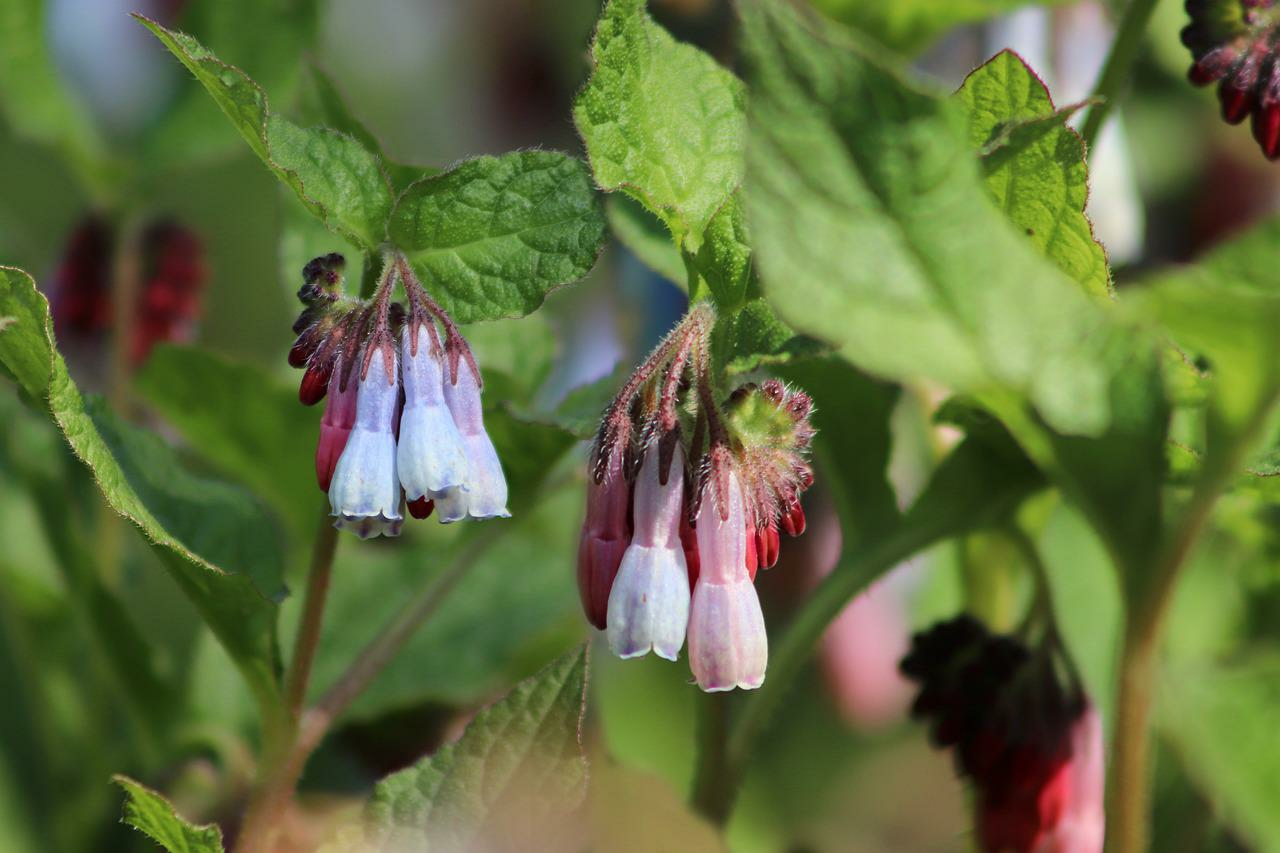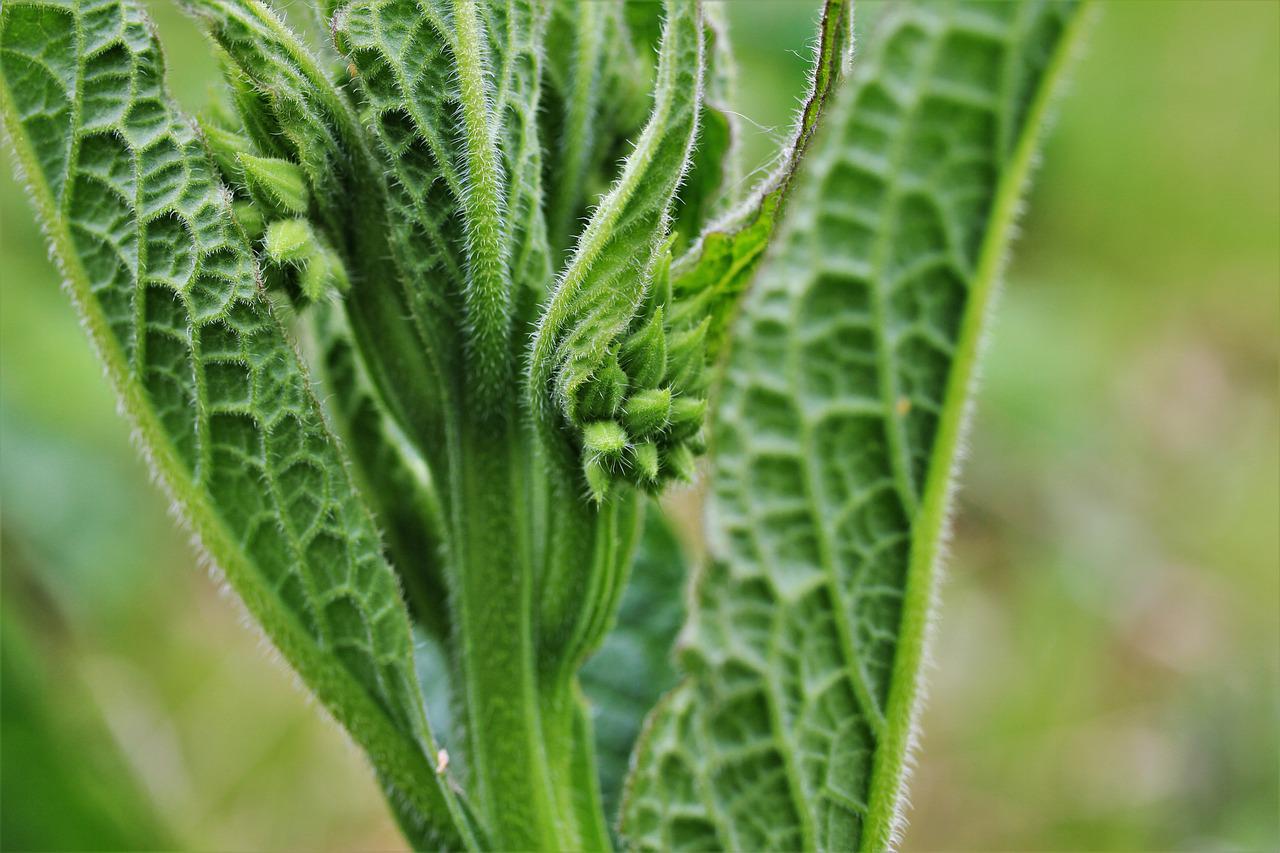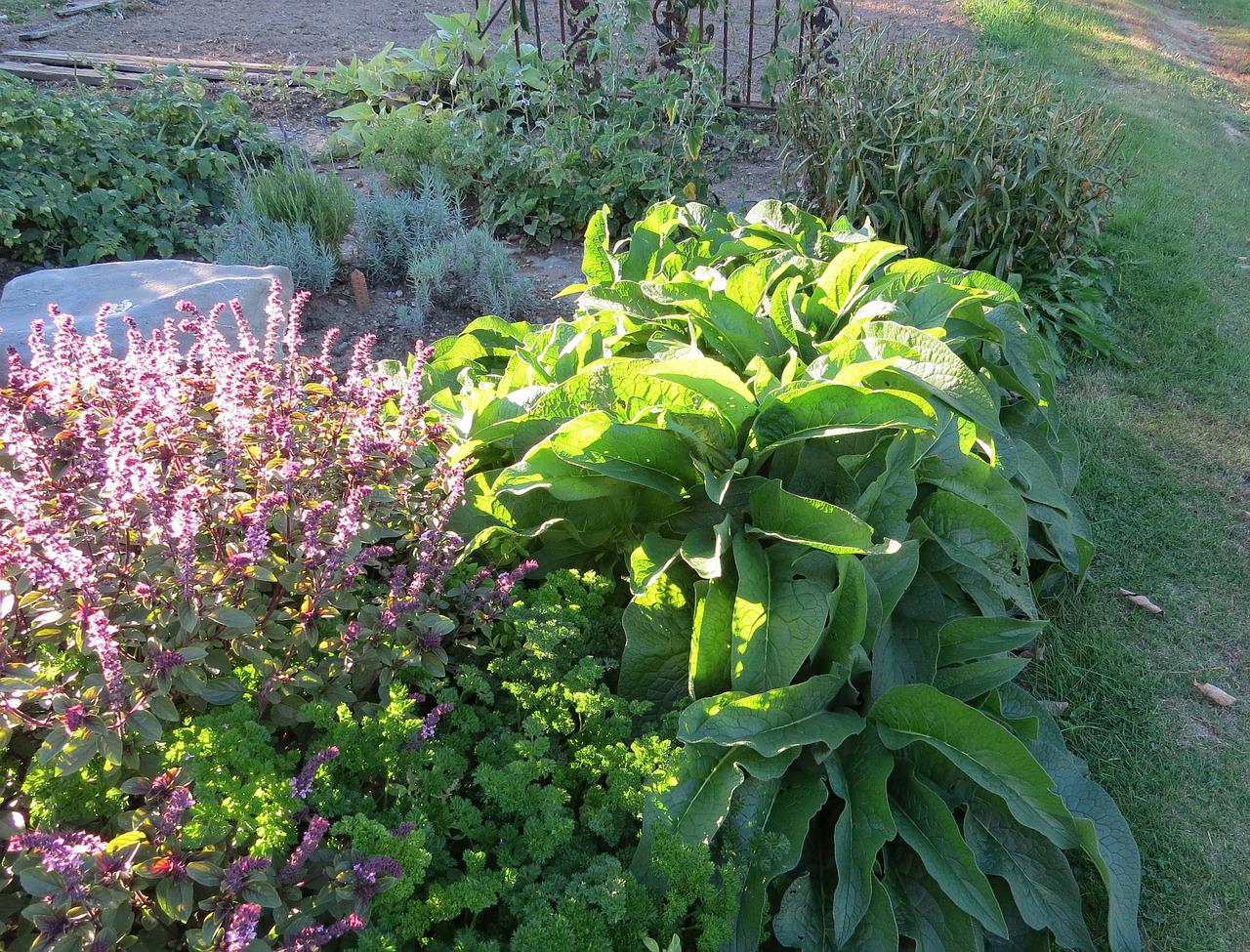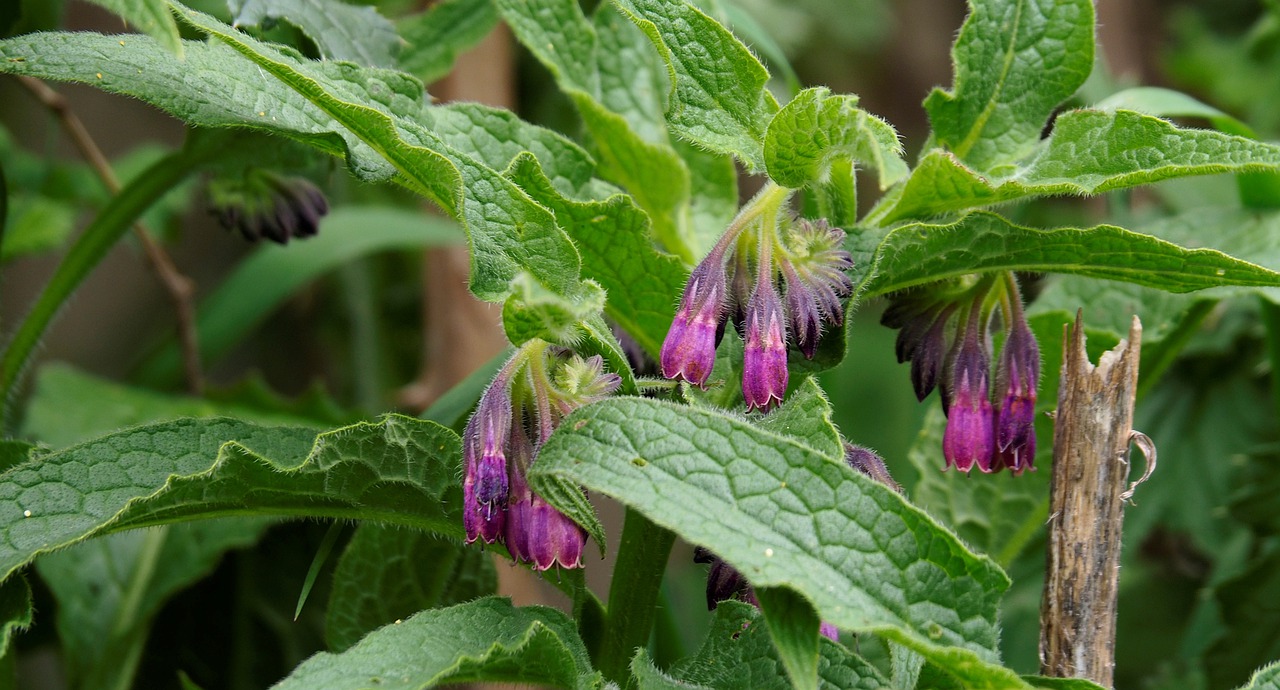
Sowing, Propagating and Harvesting Comfrey
Comfrey has long been used as a medicinal plant due to its anti-inflammatory effect. It is also useful in the garden as a fertilizer and mulching material and is also extremely attractive to bumblebees. Find out everything you need to know about sowing, planting, harvesting and using comfrey in the garden as a fertilizer in this article.
This Article Contains:
- Planting Comfrey: What You Need to Know
- The Comfrey Plant: What Does Comfrey Look Like?
- Origin: Where Does Comfrey Grow?
- Location & Soil
- Propagating Comfrey: Here’s How
- Sowing Comfrey
- Comfrey Care: Watering, Fertilizing, Pruning
- Harvesting Comfrey: Leaves & Roots
- Tips for Use in the Garden
- Comfrey Manure as Organic Fertilizer
- Frequently Asked Questions About Comfrey Plants
Quick Overview
Growing Comfrey: The Right Location & Soil
- Light: sunny to semi-shady
- Soil: loamy, nutrient-rich and humus-rich (heavy soil)
- Moisture: moist
Use in the Garden
- Fertilizer (rich in potassium, phosphorus and nitrogen)
- Plant strengthening agents
- Mulch material
- Soil improvement
Propagating and Planting Comfrey: Sowing or Cuttings?
- Flowers are often sterile and do not produce seeds
- Therefore mainly vegetative propagation by cutting off root suckers
- Planting distance: 40 x 50 cm/15.7 x 19.7 in
Planting Comfrey: What You Need to Know
The genus comfrey (Symphytum) comprises around 40 species that are native to Eurasia and North Africa. There are different varieties within the species of comfrey (Symphytum officinale). The 'Moulin Rouge' variety, for example, is particularly decorative due to its purple-red flowers and mainly blooms from May to July. But it is not only comfrey that is very popular in the garden. Caucasian com frey (Symphytum grandiflorum) is also widespread and is often planted as an ornamental perennial. The varieties range from 'Miraculum' with white-pink-red flowers to 'Hidcote Blue' with deep red buds and whitish-pale blue flowers to 'Blue Bells' with large, blue-violet flowers and wine-red buds.
Common Comfrey
Comfrey (Symphytum officinale), along with forget-me-not (Myosotis), bee's friend (Phacelia tanacetifolia) and viper's bugloss (Echium vulgare), is a member of the borage family (Boraginaceae). It is known by many names: True comfrey, common comfrey, medicinal comfrey, comfrey, hernia, comfrey root, comfrey root or comfrey root. Many names already indicate its use as a medicinal plant. Due to its poisonous ingredients, comfrey is only used externally in the form of ointments or tinctures. You can find out How to Make Your Own Comfrey Ointment in this article. There are also tips on the effects and use of comfrey as a medicinal plant.
The Comfrey Plant: What Does Comfrey Look Like?

Comfrey is a herbaceous perennial that dies above ground in winter and sprouts again in spring. It grows to a height of approx. 50 - 80 cm/19.7 - 31.5 in and a width of 30 - 40 cm/11.8 - 15.7 in. Stem and leaves are bristly and hairy, the whole plant forms clumps with creeping underground runners. The main root is a taproot and grows up to 50 cm/19.7 in long. It is dark brown-black on the outside, but white and slimy on the inside. It is primarily used for medicinal purposes. The large leaves of Symphytum officinale are oval-lanceolate and pointed at the front, growing up to 25 cm/9.8 in long.
The flower color varies between white, purple, blue or pink, depending on the variety. The inflorescences are arranged in clusters and bear drooping, bell-shaped single flowers. They are pollinated almost exclusively by bumblebees and large wild bees, as they are specially adapted to the shape of the flower with their long proboscis. The flowering period extends from May to September. The flowers are often sterile and do not produce seeds. If fertilization does occur, so-called clausal fruits are produced, which break up into egg-shaped sub-fruits. Reproduction is usually vegetative via runners from the rhizome.

Want to Exchange With Other Gardeners?
To exchange ideas with other gardeners and benefit from the experiences of others, you can visit our Fryd community.
Join Community NowOrigin: Where Does Comfrey Grow?
Comfrey is native to the whole of Europe from the Mediterranean to the Caucasus. As a native wild herb, it can be found in species-rich meadows and along forest and roadsides. It generally prefers moist areas and therefore often grows along streams or ponds. The hardy perennial was already valued by the Romans as a medicinal herb and was also a must in Hildegard von Bingen's medicinal garden.
Location & Soil
Choose a sunny to semi-shady location for your comfrey plant. The soil can be a little heavier. A loamy, nutrient-rich and humus-rich soil is ideal for the perennial. The location should be moderately dry to moist; very dry places in the garden are rather unsuitable for this wild plant. Comfrey is well suited for planting under shrubs and trees. Pond banks or next to the compost heap also provide ideal conditions for comfrey.

Propagating Comfrey: Here’s How
Comfrey tends to proliferate due to its underground runners and can therefore also be grown in large containers. Ensure good drainage and use a mixture of garden soil and sand as a substrate. If you already have a perennial, you can easily propagate it. The plants have great regenerative power and individual root pieces grow into strong new plants.
The most common method is vegetative propagation by cutting off root suckers in the spring or after flowering in the fall. As a rule, part of the root (with buds) is cut off with a sharp spade in spring and transplanted. Pre-grown young plants are available from any well-stocked nursery or garden center. When planting, you should dig a generous planting hole and fill it with potting compost. Plant individual perennials 40 x 50 cm/15.7 x 19.7 in apart.
Sowing Comfrey
It is also generally possible to sow Symphytum officinale. They can be sown in the fall in pots that overwinter in a cold frame or in March on a warm windowsill. Use low-nutrient potting compost for growing, as this is the best way for the sprouts to develop. As an alternative to growing in pots, comfrey can also be sown directly outdoors from April. The sowing depth is always 5 cm/1.9 in. Transplant the young perennials into nutrient-rich soil after three weeks. The young plants can then be planted in their final location from May. Once established, it is difficult to transplant due to its deep taproot.
The flowers are often sterile and do not produce seeds, so propagation is usually vegetative via runners from the rhizome. If seeds do form, you can collect the entire seed heads (clauses) in the fall, dry them and store them until sowing in the spring. Comfrey germinates relatively irregularly and can take up to 20 weeks. Sowing is therefore not always successful, but it is worth a try for those who like to experiment.

Comfrey Care: Watering, Fertilizing, Pruning
As a wild plant, comfrey is very adaptable and easy to care for. It grows best in moist soil. In the first year after planting, it should therefore always be watered sufficiently so that the young plants grow well. Mulching with organic material helps to retain moisture in the soil over a longer period of time. Once the comfrey has settled in properly, it can also draw water from the deeper soil layers via its taproot and no longer needs as much additional watering, you only need to water occasionally in dry summers.
Symphytum officinale is a perennial plant and is often found in the same place for several years, so the nutrient supply in the soil can become somewhat meagre at some point. Especially if the comfrey is abundantly harvested, you should fertilize it with some mature compost in spring.
After flowering, cut the stems about 10 cm/3.9 in above the ground so that the comfrey does not seed out and spread uncontrollably. Pruning also encourages new growth and bushy growth the following year. Occasionally, fungal diseases such as rust or powdery mildew can attack the perennial. Cut off diseased parts of the plant close to the ground and dispose of them. The fungal remains should not be composted as the spores are very persistent.

Harvesting Comfrey: Leaves & Roots
Fresh leaves can be harvested all year round as required. However, in order not to weaken the comfrey itself too much, only the non-flowering shoots should be harvested and no more than four times a year. The roots are only harvested from biennial plants. Dug up in the fall, they can be used dried or fresh.
Tips for Use in the Garden
Due to its high potassium and phosphorus content, comfrey is used as a natural fertilizer in the garden. The nutrient-rich leaves are also particularly suitable as mulch for heavy feeders such as tomatoes, peppers, celery, cabbage and potatoes. The leaves can also be cut into small pieces and mixed with nettles. Comfrey can also act as a plant tonic and help diseased plants. Gooseberries affected by mildew, for example, can be made more resistant and robust by mulching with comfrey. In gardens with particularly heavy soils, comfrey can be used for natural soil improvement. The strong taproots help to loosen the soil and ensure better aeration of compacted areas.

Comfrey Manure as Organic Fertilizer
In addition to nitrogen, comfrey also contains particularly high levels of phosphorus and potassium, as well as numerous micronutrients and silicic acid. The brew is used as a fertilizer and as a plant-strengthening herbal slurry. The nutrient-rich liquid manure can help to make your vegetable plants and shrubs more resistant to diseases and pests. Due to its high potassium content, comfrey liquid manure is particularly suitable for crops that require potassium, such as tomatoes, potatoes and berries.
Comfrey is a plant with many benefits and a long-standing tradition. We hope this insight has inspired you to integrate comfrey into your own garden.
If you have any questions or comments, please write to us at [email protected]. Would you like to receive helpful gardening tips all year round and plan your own beds optimally? Then register here or download the Fryd app for Android or iOS.
Fryd - your digital bed planner
Cover picture by Annette Meyer on Pixabay.

Annabell
Annabell is studying agricultural biology at the University of Hohenheim. She also enjoys gardening in her private life, spends a lot of time in nature and loves to be creative.
Learn MoreCurrent Topics in the Community

We had an olive tree ... when it didn't survive a harsh winter, my husband and our children turned it into this sculpture - a real #heart element in our garden. We planted a rambler rose on the second olive tree, which enchants us every year with its white flowers. It looks as if it were a flowering rose bush ....

Liked 5 times
May I introduce: my roommates Max (left) and Moritz. Max is a "sweet starter", which I used for the panettone and I can say it's much better than the store-bought one! The baguette (ok I still have to work on the perfect shape 🤣) with yeast only. The Moritz is a rye sourdough and is used for Vintschgauer.

Hello lovelies I am new to gardening What recommendations do you have for buying seeds? Or which stores can you recommend? I'm planning to start with the classics Onions, potatoes, garlic, carrots, herbs, lettuce, tomatoes, peas, beet and pumpkin
Show 3 answersPopular Articles

Overwintering Parsley: How to Do It Successfully

How to Grow Lettuce in Winter: Varieties, Sowing, Harvesting

Growing Sage Plant: Tips for Sowing and Harvesting

What Herbs Can Be Planted Together?

Create & Design a Permaculture Garden

Overwintering Plants: Tubs, Pots and Raised Beds

Pruning, Fertilizing & Propagating Currants: Care Tips

Pruning Raspberries: How to Do It

Vegetable Garden With Greenhouse: How to Use Greenhouse Effect

Winterizing Beds and the Garden: How to Do It
FAQ
Comfrey is a medicinal plant from the broadleaf family that is known for its anti-inflammatory and wound-healing properties. Comfrey is also used in the garden as an organic fertilizer and plant strengthening agent.
Comfrey usually flowers from May to September, depending on the variety and location. The flower color varies between white, purple, blue and pink.
Comfrey grows best in moist, nutrient-rich soil in semi-shady locations. Very dry places are rather unsuitable, as comfrey feels more at home in heavy soils.
Comfrey is a perennial shrub that retracts into the ground in winter, dies back above ground and sprouts again in spring.